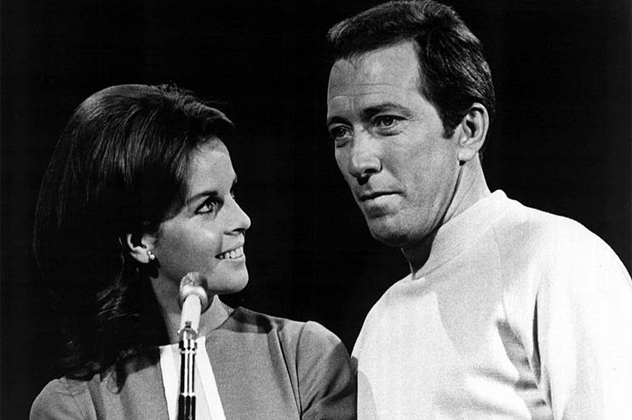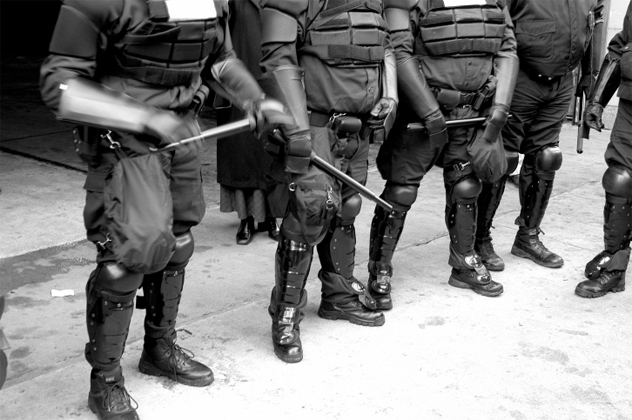 Creepy
Creepy  Creepy
Creepy  Technology
Technology 10 Scientific Breakthroughs of 2025 That’ll Change Everything
 Our World
Our World 10 Ways Icelandic Culture Makes Other Countries Look Boring
 Misconceptions
Misconceptions 10 Common Misconceptions About the Victorian Era
 Mysteries
Mysteries 10 Strange Unexplained Mysteries of 2025
 Miscellaneous
Miscellaneous 10 of History’s Most Bell-Ringing Finishing Moves
 History
History 10 Great Escapes That Ended Right Back in Captivity
 Weird Stuff
Weird Stuff 10 Fascinating Things You Might Not Know About Spiders
 Food
Food 10 Everyday Foods You Didn’t Know Were Invented by the U.S. Military
 History
History 10 Odd Things Colonial Americans Kept at Home
 Creepy
Creepy 10 More Representations of Death from Myth, Legend, and Folktale
 Technology
Technology 10 Scientific Breakthroughs of 2025 That’ll Change Everything
 Our World
Our World 10 Ways Icelandic Culture Makes Other Countries Look Boring
Who's Behind Listverse?

Jamie Frater
Head Editor
Jamie founded Listverse due to an insatiable desire to share fascinating, obscure, and bizarre facts. He has been a guest speaker on numerous national radio and television stations and is a five time published author.
More About Us Misconceptions
Misconceptions 10 Common Misconceptions About the Victorian Era
 Mysteries
Mysteries 10 Strange Unexplained Mysteries of 2025
 Miscellaneous
Miscellaneous 10 of History’s Most Bell-Ringing Finishing Moves
 History
History 10 Great Escapes That Ended Right Back in Captivity
 Weird Stuff
Weird Stuff 10 Fascinating Things You Might Not Know About Spiders
 Food
Food 10 Everyday Foods You Didn’t Know Were Invented by the U.S. Military
 History
History 10 Odd Things Colonial Americans Kept at Home
10 Controversial Cases Of Negligent Homicide
One of the justice system’s most unique criminal charges is “negligent homicide.” Even if the circumstances are purely accidental, an individual can be charged under this statute if they have exhibited criminal negligence and are believed to be legally responsible for someone’s death. Since the accused supposedly had no intention of killing anyone, a charge of negligent homicide will usually bring about a much lighter punishment than that of murder or manslaughter. In some cases, the punishment does fit the crime. But in other cases, a negligent homicide charge allows people to get off way too easily for displaying a callous disregard for human life.
10The Lake Mexia Drowning

Every year on June 19, it is a tradition for the small town of Mexia to hold their annual “Juneteenth” celebration to commemorate the anniversary of when slavery was abolished in Texas. However, in 1981, the celebration was marred by the controversial deaths of three young African-American men. That night, Carl Baker, Steve Booker, and Anthony Freeman were among the thousands of people celebrating at Booker T. Washington Park on the shores of Lake Mexia. During the festivities, they were approached by two deputy sheriffs, Kenny Elliott and Kenneth Archie, and a probation officer named David Drummond. When marijuana and prescription pills were found in their possession, the three young men were arrested.
Because the Juneteenth celebration had clogged the roads with people, the officers decided to place the three youths in a metal fishing boat and transport them to the police precinct on the other side of the lake. Only a few minutes after leaving shore, the boat suddenly capsized. The three officers survived and swam to safety, but the three youths all drowned.
Suspicion instantly surrounded the incident, especially since Baker and Booker were both known for being very good swimmers. Even if the tragedy had been an accident, the boat was only certified to carry the weight of three people, and the officers had violated the law by not giving their prisoners life jackets. There were also differing eyewitness accounts about whether the three youths were handcuffed when they were placed inside the boat. The three officers were indicted on charges of criminally negligent homicide, but were ultimately acquitted by an all-white jury.
9The Ribbon Creek Incident

In 1956, Staff Sergeant Matthew McKeon was a junior drill instructor at the Marine Corps Recruit Depot in Port Royal, South Carolina. He oversaw 75 young recruits in Platoon 71. On the evening of April 8, Sgt. McKeon was concerned about the lack of discipline in his platoon, so he made the last-minute decision to take the recruits on a training exercise through the swampy Ribbon Creek marsh. When they arrived at the marsh, McKeon ordered his men to follow him into the water. Even though the area seemed relatively shallow, the high tide soon started pulling the recruits into deeper water. Since some of the men could not swim, panic began to ensue. McKeon eventually led his platoon out of Ribbon Creek, but six recruits wound up drowning.
When news of the tragedy spread, there was a public outcry about the Marine Corps’ training methods. Adding to the controversy was the fact that McKeon had been drinking earlier that day, and false rumors started spreading that McKeon had been intoxicated when he led his platoon into the marsh. The Marines ultimately decided to court-martial McKeon. However, many witnesses defended McKeon’s actions at the trial, including the highly decorated Lt. General Lewis “Chesty” Puller, who argued that leading recruits into water was a standard training exercise and that their deaths were nothing more than a tragic accident.
In the end, McKeon was acquitted of the more serious charge of manslaughter, but was found guilty of negligent homicide and drinking on duty. He was sentenced to nine months of hard labor, a reduction of rank, and a bad-conduct discharge. The sentence was later reduced and McKeon went back to active duty until he was medically discharged from the Marines three years later.
8The Shooting Of Spider Sabich

Originally born in Paris, Claudine Longet moved to America at the age of 19 and got married to famous pop singer Andy Williams in 1961. It wasn’t very long before she found fame through a successful singing and acting career. After divorcing Williams in 1975, Longet became romantically involved with Olympic alpine skier Vladimir “Spider” Sabich. However, a shocking tragedy ended their relationship on March 21, 1976. Sabich returned to their home in Aspen, Colorado and was preparing for a shower in the bathroom when he was shot in the abdomen by Longet. She remained at Sabich’s side as he died on the way to the hospital, but was later charged with manslaughter.
Longet always maintained that the gun had accidentally misfired while Sabich was showing her how to use it. Prosecutors claimed that a blood sample taken from Longet showed the presence of cocaine in her blood at the time of the shooting. They also wanted to introduce Longet’s diary into evidence, which allegedly contained details about her floundering relationship with Sabich. However, because police had obtained the diary and Longet’s blood sample without warrants, they could not be used at trial.
Since there was not enough hard evidence to support a charge of manslaughter, the jury decided to convict Longet of criminally negligent homicide. She was ordered to pay a $250 fine and spend 30 days in jail. Sabich’s family filed a wrongful death civil lawsuit against Longet, and one of the conditions of their settlement was a confidentiality clause which would prevent her from publicly talking about the shooting. Claudine Longet has led a very private life away from the spotlight ever since.
7The Gilchrest Road Crossing Accident

On the morning of March 24, 1972, a school bus was transporting 49 students to Nyack High School in Rockland County, New York. After being forced to take a detour, the 35-year-old bus driver, Joseph Larkin, was running late and was speeding through the town of Congers. The bus eventually reached the Erie and Penn Central railway crossing on Gilchrest Road. Unfortunately, Larkin did not seem to notice that a large freight train pulling 83 cars was heading toward them. When the school bus rolled across the tracks, the train crashed right through it, breaking the bus completely in half. In the end, five students were killed, three of them lost limbs, and nearly everyone on the bus suffered serious injuries.
At the time, the Gilchrest Road crossing did not have any flashing lights or safety gates to warn drivers about incoming trains. However, most of the blame fell squarely on Joseph Larkin, who was charged with criminally negligent homicide. Larkin always maintained that he came to a complete stop before crossing the railway tracks, but did not see the train. However, numerous witnesses claimed that the bus had not stopped at all. They believed the crash was the result of Larkin recklessly making an attempt to beat the train. In the end, Larkin was found guilty of five counts of negligent homicide, but did not do any jail time in lieu of five years’ probation.
6The Greenwich Village Townhouse Explosion

In the late 1960s, Cathlyn Wilkerson joined the Weather Underground Organization, one of the most infamous radical groups in the United States. However, after a tragic accident on March 6, 1970, the 25-year-old Wilkerson would find herself a fugitive from justice. At the time, Wilkerson was allowing members of the Weather Underground to use her father’s Greenwich Village townhouse in Manhattan to plan a future attack. Shortly before noon that day, the house suddenly went up in an explosion, and Wilkerson and another member of the group, Kathy Boudin, emerged from the wreckage. After recovering from the blast at a neighbor’s house, the two women disappeared and went underground for the next decade.
The bodies of three Weather Underground members—Terry Robbins, Theodore Gold, and Diana Oughton—were discovered at the scene. The group had been assembling nail bombs made out of dynamite in the basement, which they were eventually planning to use to attack the Fort Dix army base. At some point, one of the bombs accidentally went off, causing the entire townhouse to collapse. Wilkerson and Boudin wound up surviving because they were upstairs at the time. Afterward, a nationwide manhunt for both women was launched. Wilkerson managed to avoid detection until 1980, when she finally decided to turn herself in. She was sentenced to three years in prison for negligent homicide, but was released after serving 11 months. One year later, Kathy Boudin was captured after participating in an unrelated robbery. She received a 20-year sentence.
5The Drowning Of Joe Campos Torres

One of the most controversial incidents of police brutality involved a 23-year-old Vietnam War veteran named Joe Campos Torres. On the evening of May 5, 1977, Torres was having drinks at a Houston bar after spending most of the day on a drinking binge. When Torres got into an altercation with two other customers, the owner attempted to eject him from the establishment. Three Houston P.D. officers arrived and handcuffed Torres before putting him in their patrol car. However, when two other patrol cars arrived at the scene, six of the officers made the mutual decision to take Torres to a rundown warehouse in the Buffalo Bayou area in order to “rough him up.”
At the warehouse, the handcuffed Torres was beaten severely before he was taken to the city jail. The duty sergeant refused to book him and told the officers to take Torres to the hospital to get his injuries treated. When Torres continued to cause trouble, the officers decided to take him back to the Buffalo Bayou to beat him some more. After removing his cuffs, they tossed Torres into the Bayou before driving away.
Even though Torres had allegedly assured the officers that he could swim, he wound up drowning and his body was found three days later. The two officers who orchestrated the whole incident, Terry Denson and Steven Orlando, stood trial for murder, but in the end they were only convicted of negligent homicide. Their punishment amounted to one years’ probation and a fine of $1. The verdict outraged the Hispanic community and helped incite a riot at Moody Park. The community later received some justice when Denson and Orlando, along with Officer Joseph Janish, were given a nine-month prison term for civil rights violations.
4The Cavalese Cable Car Disaster

In 1998, the United States and Italy found themselves experiencing a diplomatic relations nightmare because of a tragic incident which took place on February 3. That day, a Marine aircraft known as an EA-6B Prowler took off from Aviano Air Base in Italy for a seemingly routine training mission. The Prowler was flown by Captain Richard J. Ashby, and Captain Joseph Schweitzer was the navigator. They were traveling at approximately 870 kilometers per hour (540 mph) when they flew past a ski resort near the community of Cavalese. However, the Prowler was flying underneath its mandatory minimum altitude and passed far too close to a cable car transporting skiers down from the top of Mount Cermis. The aircraft’s right wing sliced through the cable and all 20 people inside the gondola plummeted to their deaths.
Even though there were four crew members aboard the aircraft, only Ashby and Schweitzer would face charges of negligent homicide and involuntary manslaughter. After Ashby stood trial and was acquitted, all charges against Schweitzer were subsequently dropped. The Italian government was outraged by the decision, but they did receive a little bit of justice once it was discovered that Ashby and Schweitzer had recorded a video inside the cockpit on the day of the accident and had later destroyed it in a bonfire. They were both court-martialed for obstruction of justice. Ashby was given a six-month prison term and both Marines were dismissed from service.
3The Crash Of Aeroperu Flight 603

On October 1, 1996, Aeroperu Flight 603 took off from Miami International Airport. Its final destination was Santiago, Chile, but the flight made a scheduled stopover in Lima, Peru, where many of the passengers transferred to a Boeing 757 for the remainder of the trip. Shortly after takeoff, the flight crew noticed that the navigational instruments were not working properly and decided to return to the airport. However, because it was dark and foggy and the instruments were giving out incorrect information, the pilots were unable to see where they were going. They wound up crashing into the Pacific Ocean and all 70 people aboard Flight 603 lost their lives.
An investigation revealed that the tragic crash was caused by a piece of masking tape. The Boeing 757 had been cleaned prior to takeoff, but the tape was accidentally left over the static ports. This screwed up the plane’s sensors and interfered with the instruments. As a result, the pilots were unable to receive proper readings about their altitude, which ultimately caused them to crash into the ocean. Because of this mistake, Aeroperu was forced to pay a $29 million settlement to the victims’ families. The individual who forgot to remove the tape from the static ports was a maintenance worker named Eleuterio Chacaliaza, who was charged with criminally negligent homicide. He served a two-year-suspended sentence which prevented him from working during that time.
2The Shooting Of Felix Pappalardi

For two decades, Felix Pappalardi had a very successful career in the music industry. He was the bass player for the rock band Mountain and produced several hit albums for various bands. During the 1960s, he got married to a woman named Gail Collins, who wrote lyrics for some of her husband’s songs. However, by the time the 1980s rolled around, Felix was heavily into drugs and his marriage to Gail was in turmoil. Even though the couple had an open marriage, Gail became very jealous of Felix’s relationship with an aspiring singer. In the early-morning hours of April 17, 1983, Felix returned to the couple’s Manhattan apartment after a night with the singer and got into a heated argument with Gail. The confrontation ended with Gail shooting Felix in the neck with a .38-caliber Derringer.
Gail claimed that she accidentally shot her husband while he was teaching her how to use the gun, but there was a lot of evidence that pointed to murder. The couple’s marriage certificate was found torn up in the trash basket and, after shooting Felix, Gail had not immediately called for medical attention. Instead, she decided to contact her lawyer for legal advice while her wounded husband lay bleeding on the floor. Gail was charged with second-degree murder, but at the trial, the jury ultimately believed her claims that the shooting was an accident. In the end, they only found her guilty of the lesser charge of criminally negligent homicide. The trial judge was disgusted by the verdict and actually delivered a harsh lecture to the jury before giving Gail Collins-Pappalardi the maximum sentence of four years.
1The Starvation Of Tyler Walrond

One of the most unusual convictions for criminally negligent homicide involved Tabitha Walrond, a 19-year-old mother from New York. In 1997, Tabitha gave birth to a baby boy named Tyler. Seven weeks later, Tyler died of malnutrition, weighing only 2.2 kilograms (5 lb) at the time of his death. Tabitha was estranged from the baby’s father, who had left her for another woman, and he was convinced that Tabitha had deliberately starved Tyler as a form of revenge. After he presented this theory to prosecutors, they elected to charge Tabitha with second-degree manslaughter. Tabitha went on trial in May 1999. While the jury decided to acquit her of the manslaughter charge, she was still convicted of negligent homicide.
The case generated a lot of controversy. Since Tabitha had breast-fed Tyler on a consistent basis since his birth, her supporters did not believe that she had any intention of starving her baby. The problem was that Tabitha had gotten two breast reductions at the age of 15 and was never told that such surgeries would cause her breasts to produce insufficient milk. When Tabitha noticed that Tyler seemed to be losing weight, she did attempt to schedule an appointment with a doctor, but she was turned away because Tyler did not have Medicaid.
After navigating through a bureaucratic maze to get proper treatment for her baby, Tabitha finally received Tyler’s Medicaid card—two months after his death. In spite of the controversy, Tabitha Walrond’s negligent homicide conviction remained on her record, but the trial judge chose to spare Tabitha any jail time and sentenced her to five years’ probation instead.
Robin Warder is a budding Canadian screenwriter who has used his encyclopedic movie knowledge to publish numerous articles at Cracked.com. He is also the co-owner of a pop culture website called The Back Row and recently worked on a sci-fi short film called Jet Ranger of Another Tomorrow. Feel free to contact him here.








